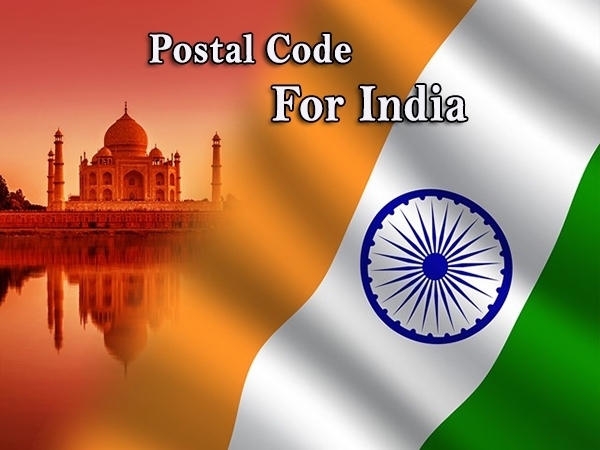Postal Code India
The term Postal Index Number or PIN is also widely known as PIN code in India. It refers to the code in the post office number of the postal code system which is predominantly used in the India Post to segregate the mails. The Postal Index Number consists of six long digits. This system of coding the postal address was introduced way back in 1972 by Shriram Bhikaji Velankar, who was the then additional secretary in the Union Ministry of Communications.
The main reason behind the introduction of the PIN-code system in India was to help the postal departmental staff in manually sorting and delivering the mail to the accurate address and thus eliminating the confusion over similar place names, incorrect addresses, different languages used by the public.

India Zipcode Structure
The Postal Index Number or PIN consist of six long numerical digits and each of them indicates regions. The first digit denotes the zone The second digit indicates sub-zone The third digit along with the first two will indicate the sorting district within the zone. The last final three digits indicate the individual post offices within the sorting districts. Find your postal codes by selecting your state, district, post office of your locality from Goodreturns Pin Code Finder.
India Zipcode Zones
There are 9 postal zones in India in which 8 are regional and 1 is dedicated exclusively for Indian Army and is known as functional zone. The very first digit of the PIN code indicates the zone and is allocated across the 9 zones which are spread across the length and breadth of the country.
A Postal Index Number or PIN or Pincode is a code in the post office numbering or post code system used by India Post. It is a 6 digit code. The first digit indicates the region, second digit indicates sub-region and the third digit indicates the sorting district within the region. The final three digits represent individual post offices.
Postal code range of India lies between 110001 – 855117.The postal code range for different states in India is given below:
REGION | ISO 3166-2:IN | Zipcode Prefix |
Delhi | DL | 11 |
Haryana | HR | 12-13 |
Punjab | PB | 14-15 |
Chandigarh | CH | 16 |
Himachal Pradesh | HP | 17 |
Jammu & Kashmir | JK | 18-19 |
Uttar Pradesh, Uttarakhand | UP, UT | 20-28 |
Rajasthan | RT | 30-34 |
Diu & Daman | DD | 396210 |
Dadar & Nagar Haveli | DN | 396 |
Gujarat | GJ | 36-39 |
Goa | GA | 403 |
Maharashtra | MH | 40-44 |
Madhya Pradesh | MP | 45-48 |
Chhattisgarh | CT | 49 |
Telangana | TG | 50 |
Andhra Pradesh | AP | 51-53 |
Karnataka | KA | 56-59 |
Puducherry | PY | 605 |
Tamil Nadu | TN | 60-66 |
Lakshadweep | LD | 682 |
Kerala | KL | 67-69 |
Sikkim | SK | 737 |
Andaman & Nicobar Islands | AN | 744 |
West Bengal | WB | 70-74 |
Odisha | OR | 75-77 |
Assam | AS | 78 |
Arunachal Pradesh | AR | 790-792 |
Meghalaya | ML | 793-794 |
Manipur | MN | 795 |
Mizoram | MZ | 796 |
Nagaland | NL | 797-798 |
Tripura | TR | 799 |
Bihar, Jharkhand | BR, JH | 80-85 |
Army Postal Service | APS | 90-99 |
India Zipcode Sorting Districts
The third digit of the Postal Code Number combined with the first two digits will represent a specific geographic region (only exception here is the functional zone which is meant for Army) and this is called as a sorting district which is headquartered at the main post office of the largest city in the region and is known by the name sorting office. Every state may have one or more sorting districts accordingly, purely based on the volume of mail handled in the region.
All About Indian Postal System
The postal department or Department of Posts in India trades under the name India Post and is run predominantly by the Government of India. This postal system is also popularly known as Post Office in India. This particular department comes under the Ministry of Communications and Information Technology of the Government of India. India is divided into 22 postal circles and each of the postal circle is headed by Chief Postmaster General. Further, each of these postal circles is broken into regions which will be taken care by a Postmaster General and the regions will be further divided into divisions, which are in turn bifurcated into subdivisions as well. Over the years, the Postal Service in India has witnessed tremendous changes and has emerged as the fastest service provider which even penetrates the remotest places across the country and offers the people to send across mails at a very minimal price. Apart from dealing with mails, India Post has also emerged as one of the small financial institutions which help citizens of this nation to save their money securely.
Postal Services in India
India Post has over 1,55,000 branches spread across various locations in the country. It has coverage of around 89% in the rural areas in the country. Department of Post performs the prominent function in rural areas as they act as a connecting chain between one village to another and between villages and cities. Other than mail services, they also provide banking facilities to the rural population as some of these places are still devoid of a proper banking facility. The modern postal service in the country is around 150-year-old and during 1854, India became the first country to issue stamps. The postal services were bought under centralized control after some time. Post-independence, the British broadened the outlook of postal services in the country as the level of investments and efforts were broadened to the existing service of the postal system. Right now, the India Post offers services from the desert land of Kutch in Rajasthan till the glaciers of Ladakh and Siachen. The following are the list of postal services provided under India Post Financial Services Allied Postal Services Mail Facilities
Financial Services
Post office in India provides as host of financial services to the general public like National Savings Certificates (NSC), Kisan Vikas Patra (KSV), Public Provident Fund (PPF) and so on. It also provides the citizens of this country to carry out conventional schemes of a postal service which performs functions similar to that of a banking institution in India which is accepting of deposits and provide the customer’s schemes which are related to their monthly income, money order facility, deposit facility in the form of savings bank account, recurring deposit account, fixed deposit account. The best part of this is, the rate of interest offered by post offices in India are comparatively higher than the ones offered in banks across the country be it public or private sector banks. Off lately, the post offices in India are also providing Sukhanya Sammriddhi Schemes (SSS or SSC) to benefit the girl child in India for her future education or to meet her marriage expenses after the girl child attains 21 years.

Allied Postal Services
India Post offers the following list of Allied Postal Services through post offices and they are:
- Greeting Post – This is a kind of post which can be sent to your beloved ones on several occasions be it birthday or anniversary and so on. Greeting posts can be sent to distant places.
- Speed Post – With the help of speed post services, you can send mails to others quickly as against the other normal mails.
- Media Post – Most of the business firms can endorse their brands using the postcards, envelops and so on using media post.
- E – bill Post – Individuals can pay their phone bills of Airtel, BSNL and other companies using e-bill postal services offered by the postal department.
- Direct Post – One can do advertising directly with the help of the addressed and unaddressed direct post.
- International Money Transfer – Individuals can receive remittances from other countries to India as India Post has collaborated with Western Union Banks.
- Passport Facilities – Indian citizens can get their passports as India Post has entered into a tie-up with the Ministry of External Affairs and individuals who are seeking to get a passport can get passport forms, fill it up and submit the same at the nearest post offices for further procedures.
- Aadhaar Card – Post offices have started to provide Aadhaar Card to the Indian citizens. The staff at the postal offices are trained to verify the details submitted by the Aadhaar applicants and after this, the biometric details of the applicant will be captured including iris scan, fingerprint scanning. Post this, the captured details along with application form will be forwarded to UIDAI, which will issue Aadhaar card to the individuals.
Mail Facilities India Post provides mail facilities and helps people to send mails from one place to another destination. This facility covers sending of mail, registration of mail as a security proof and insurance of mails to cover the possible risks involved in it.

